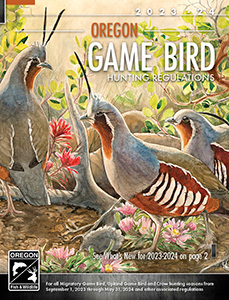Species Highlight: Chukar
Chukar are one of the most-popular upland game birds to hunt in Oregon. With abundant flocks located on public land throughout scenic eastern Oregon, these partridge have become a favorite challenge for upland hunters.

Chukar are native to some of the most rugged terrain in the world. Oregon’s chukar stock likely originated from northern India, but has adjusted well to the high desert drainages and rimrock habitats of eastern Oregon.
Oregon’s free-ranging population of chukar was initiated with the release of 280 adult birds from the Ontario Game Farm in 1951 on the west slope of Hart Mountain. Pen-raised game birds are not known to thrive for long in the wild, but after releasing over 76,000 birds, Oregon’s wild chukar populations were established.
The first chukar season in Oregon was held in the fall of 1956 with a daily bag and possession limit of 3 birds. Populations continued to increase and peaked around 1980 when 34,000 hunters harvested nearly half a million chukar in Oregon. Today harvest is more modest, averaging 41,000 birds with an 8 bird daily bag limit and a season that runs from mid-October through the end of January.
Large fluctuations in populations are common in the partridge family. Chukar tend to have short life spans, but have the ability to produce many young. Clutches up to 21 eggs have been observed. Even when chukar have a year of poor survival, they have the ability to repopulate fairly quickly.
Another remarkable quality of chukar is their ability to survive on the seemingly limited food resources of the high desert. One study of eastern Oregon chukar found cheatgrass seeds in 88% and the starchy root bulbs of the prairie star (Lithophragma sp.) in 46% of chukar crop contents. Learning to identify prairie star could make you a better chukar hunter!
When scouting for potential chukar hunting locations, look for steep rocky slopes with sagebrush and cheatgrass, but no trees. Chukar are always associated with some kind of water on the landscape, whether a creek, pond, or wildlife guzzler. You may catch them coming to water in the morning or evening, and when you hear their distinctive “chuck-chuck-chukar” call, you will know you’re in the right place!

